Abstract
BACKGROUND: It is known that theophylline reduces cerebral blood flow in humans. To quantitatively assess the possible adverse effect of theophylline on brain tissue oxygen tension (PO2) due to decreased cerebral blood flow, two sets of experiments were conducted in mildly hypoxaemic patients with chronic obstructive lung disease. METHODS: Firstly, internal jugular venous PO2 (PjO2) was measured simultaneously with arterial and mixed venous blood PO2 (PaO2 and PvO2) during right heart catheterisation in 10 subjects (mean PaO2 73 mm Hg; conversion factor: 10 mm Hg = 1.33 kPa)) before and after intravenous infusion of aminophylline (6 mg/kg). The PjO2 and PvO2 were considered to reflect the average tissue PO2 for the brain and for the whole body respectively. Secondly, the relation between PaO2 and PjO2 over a wide range, with the PaCO2 similar to that in the first study, was investigated in a different group of 12 subjects by stepwise changes in inspiratory gas composition. RESULTS: The mean PjO2 decreased by as much as 6 mm Hg 15 minutes after an infusion of aminophylline, whereas PaO2 stayed at the same level and PvO2 showed only a small decrease. The low PjO2 value of 29 (SD 6) mm Hg with aminophylline in the first study was similar to the PjO2 value of 30 (2) mm Hg obtained during severe hypoxia (PaO2 45 mm Hg) in the second study. The coefficient of oxygen delivery for the brain decreased by 29% with aminophylline treatment, but did not change significantly during severe hypoxic challenge. CONCLUSIONS: These data suggest that an infusion of aminophylline lowers brain tissue PO2 appreciably when given to mildly hypoxaemic patients with chronic obstructive lung disease.
Full text
PDF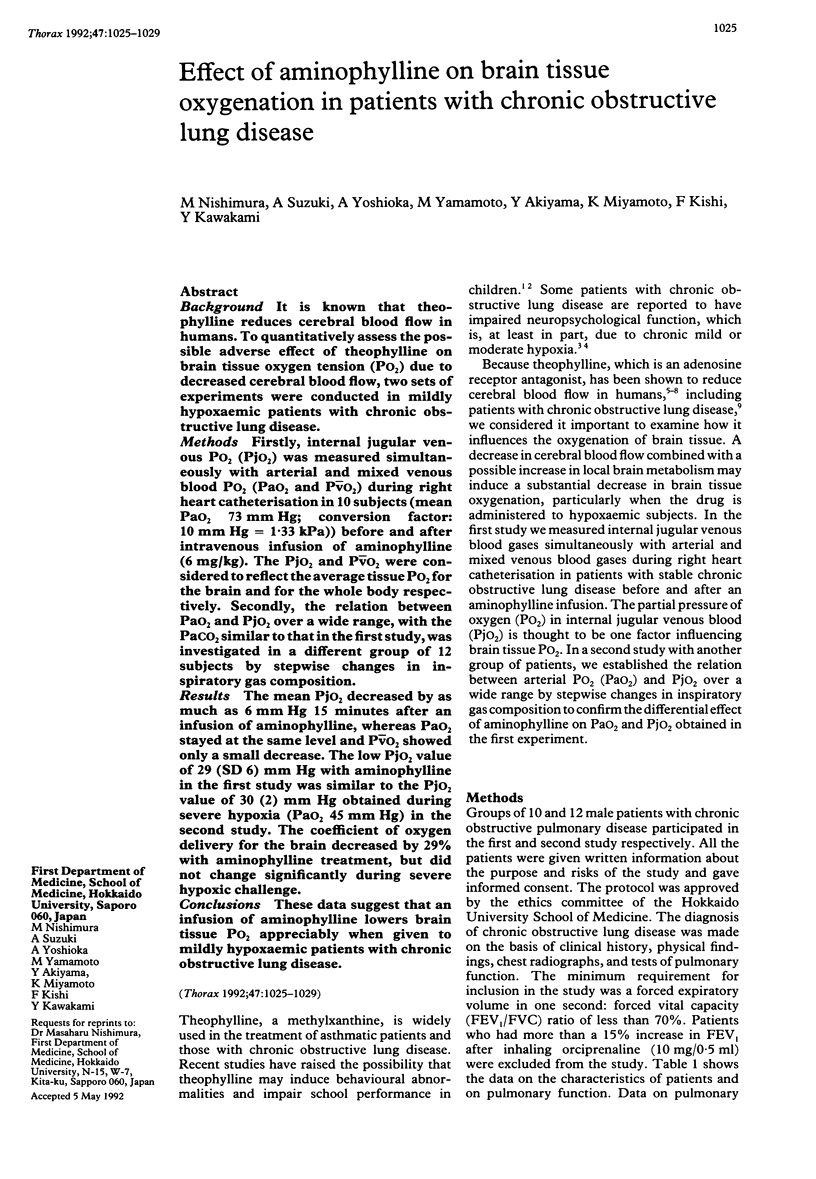
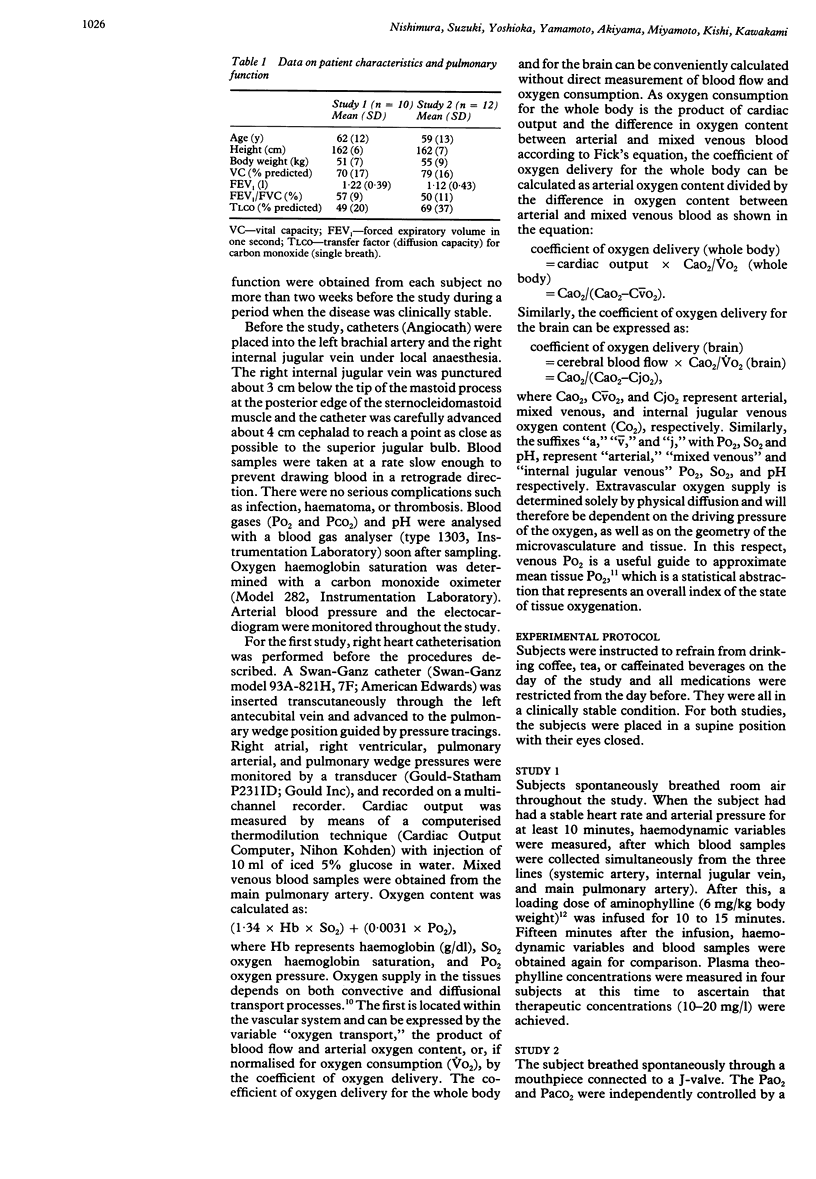
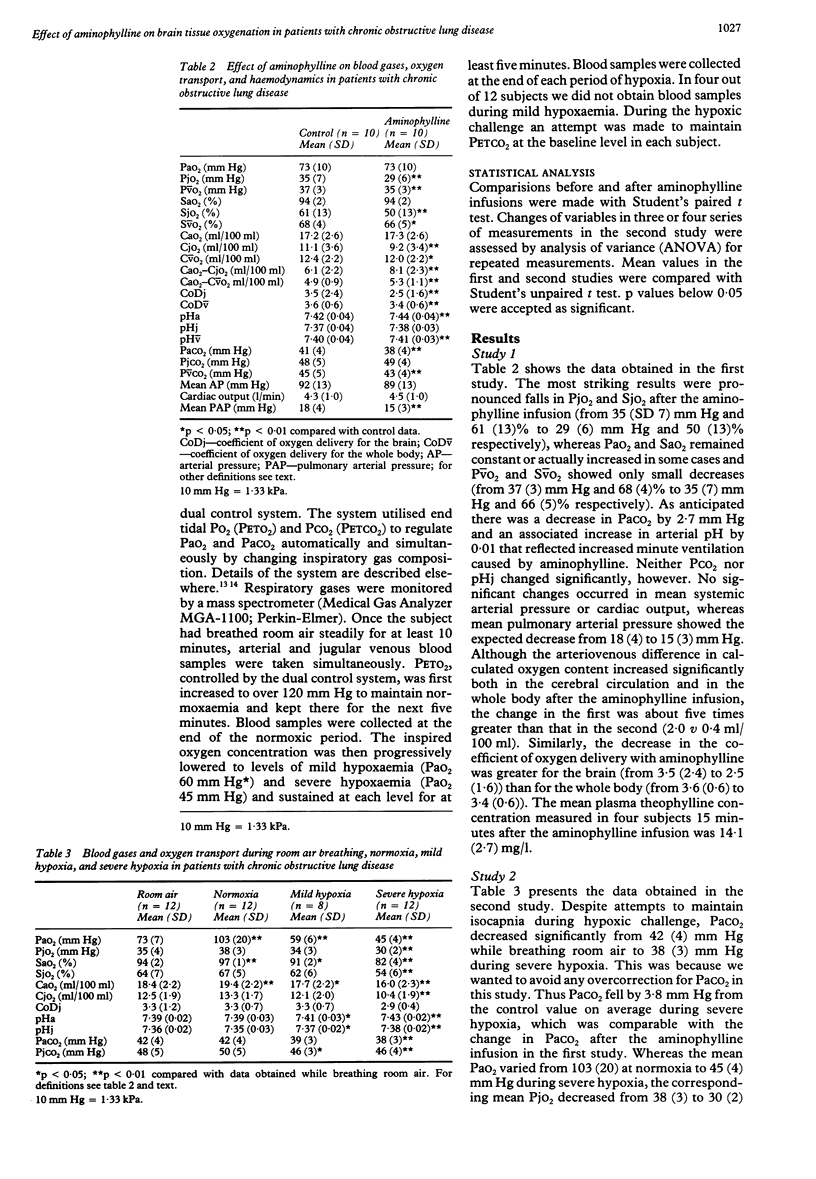
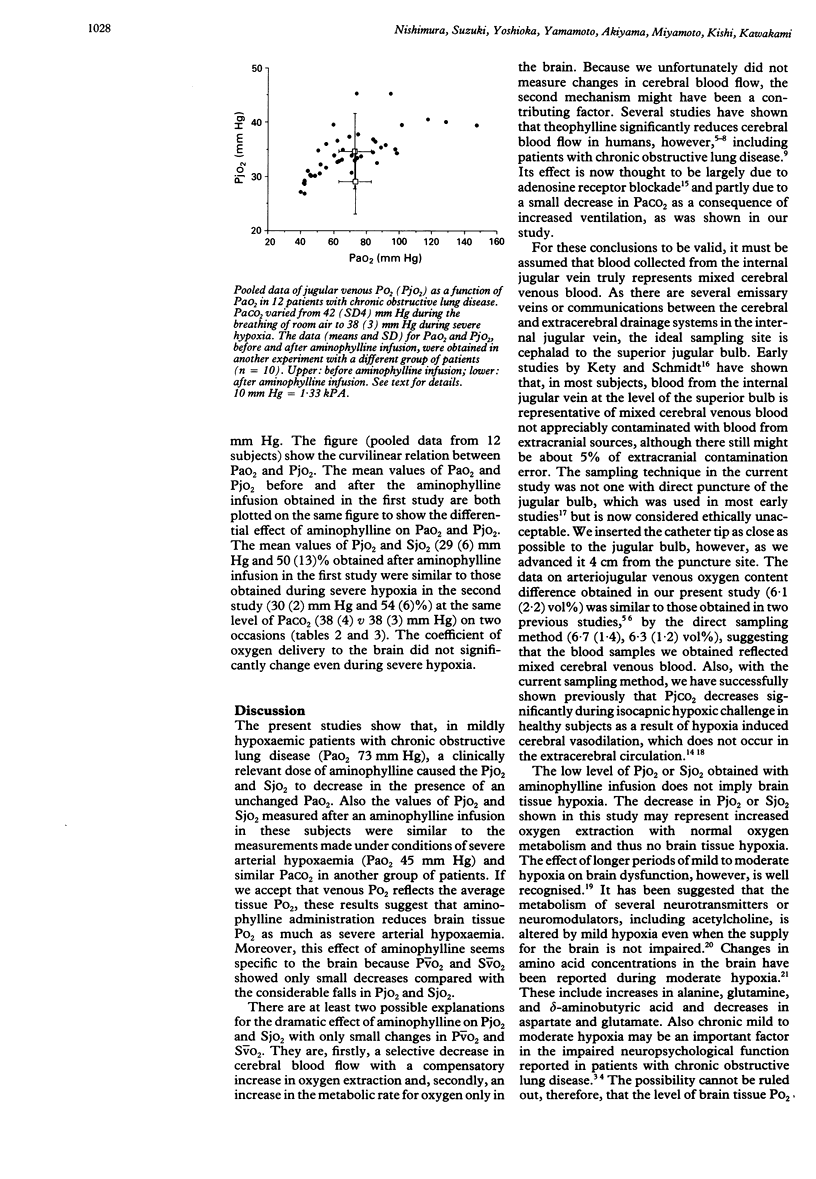
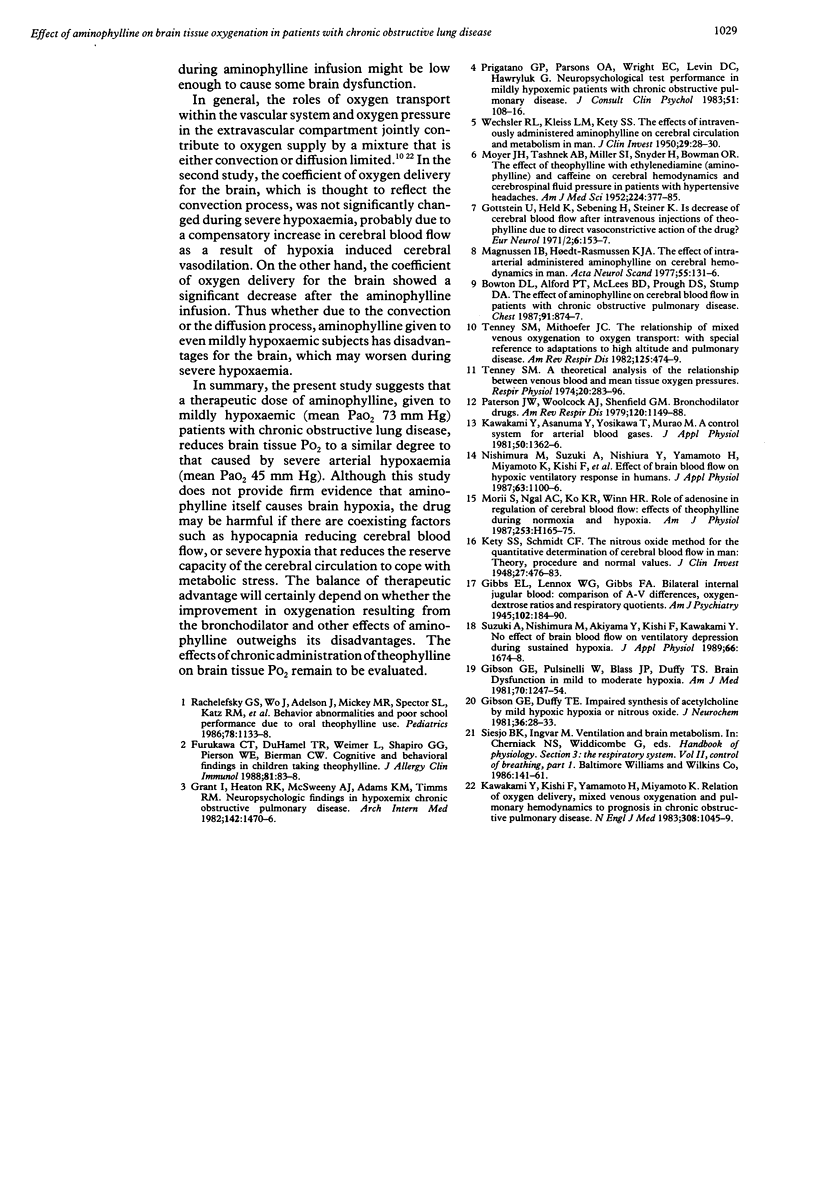
Selected References
These references are in PubMed. This may not be the complete list of references from this article.
- Bowton D. L., Alford P. T., McLees B. D., Prough D. S., Stump D. A. The effect of aminophylline on cerebral blood flow in patients with chronic obstructive pulmonary disease. Chest. 1987 Jun;91(6):874–877. doi: 10.1378/chest.91.6.874. [DOI] [PubMed] [Google Scholar]
- Furukawa C. T., DuHamel T. R., Weimer L., Shapiro G. G., Pierson W. E., Bierman C. W. Cognitive and behavioral findings in children taking theophylline. J Allergy Clin Immunol. 1988 Jan;81(1):83–88. doi: 10.1016/0091-6749(88)90224-2. [DOI] [PubMed] [Google Scholar]
- Gibson G. E., Duffy T. E. Impaired synthesis of acetylcholine by mild hypoxic hypoxia or nitrous oxide. J Neurochem. 1981 Jan;36(1):28–33. doi: 10.1111/j.1471-4159.1981.tb02373.x. [DOI] [PubMed] [Google Scholar]
- Gibson G. E., Pulsinelli W., Blass J. P., Duffy T. E. Brain dysfunction in mild to moderate hypoxia. Am J Med. 1981 Jun;70(6):1247–1254. doi: 10.1016/0002-9343(81)90834-2. [DOI] [PubMed] [Google Scholar]
- Gottstein U., Held K., Sebening H., Steiner K. Is decrease of cerebral blood flow after intravenous injections of theophylline due to direct vasoconstrictive action of the drug? Eur Neurol. 1971;6(1):153–157. doi: 10.1159/000114484. [DOI] [PubMed] [Google Scholar]
- Grant I., Heaton R. K., McSweeny A. J., Adams K. M., Timms R. M. Neuropsychologic findings in hypoxemic chronic obstructive pulmonary disease. Arch Intern Med. 1982 Aug;142(8):1470–1476. [PubMed] [Google Scholar]
- Kawakami Y., Kishi F., Yamamoto H., Miyamoto K. Relation of oxygen delivery, mixed venous oxygenation, and pulmonary hemodynamics to prognosis in chronic obstructive pulmonary disease. N Engl J Med. 1983 May 5;308(18):1045–1049. doi: 10.1056/NEJM198305053081801. [DOI] [PubMed] [Google Scholar]
- Kawakami Y., Yoshikawa T., Asanuma Y., Murao M. A control system for arterial blood gases. J Appl Physiol Respir Environ Exerc Physiol. 1981 Jun;50(6):1362–1366. doi: 10.1152/jappl.1981.50.6.1362. [DOI] [PubMed] [Google Scholar]
- Kety S. S., Schmidt C. F. THE NITROUS OXIDE METHOD FOR THE QUANTITATIVE DETERMINATION OF CEREBRAL BLOOD FLOW IN MAN: THEORY, PROCEDURE AND NORMAL VALUES. J Clin Invest. 1948 Jul;27(4):476–483. doi: 10.1172/JCI101994. [DOI] [PMC free article] [PubMed] [Google Scholar]
- MOYER J. H., TASHNEK A. B., MILLER S. I., SNYDER H., BOWMAN R. O. The effect of theophylline with ethylenediamine (aminophylline) and caffeine on cerebral hemodynamics and cerebrospinal fluid pressure in patients with hypertensive headaches. Am J Med Sci. 1952 Oct;224(4):377–385. doi: 10.1097/00000441-195210000-00002. [DOI] [PubMed] [Google Scholar]
- Magnussen I., Hoedt-Rasmussen K. The effect of intraarterial administered aminophylline on cerebral hemodynamics in man. Acta Neurol Scand. 1977 Feb;55(2):131–136. doi: 10.1111/j.1600-0404.1977.tb05633.x. [DOI] [PubMed] [Google Scholar]
- Morii S., Ngai A. C., Ko K. R., Winn H. R. Role of adenosine in regulation of cerebral blood flow: effects of theophylline during normoxia and hypoxia. Am J Physiol. 1987 Jul;253(1 Pt 2):H165–H175. doi: 10.1152/ajpheart.1987.253.1.H165. [DOI] [PubMed] [Google Scholar]
- Nishimura M., Suzuki A., Nishiura Y., Yamamoto H., Miyamoto K., Kishi F., Kawakami Y. Effect of brain blood flow on hypoxic ventilatory response in humans. J Appl Physiol (1985) 1987 Sep;63(3):1100–1106. doi: 10.1152/jappl.1987.63.3.1100. [DOI] [PubMed] [Google Scholar]
- Paterson J. W., Woolcock A. J., Shenfield G. M. Bronchodilator drugs. Am Rev Respir Dis. 1979 Nov;120(5):1149–1188. doi: 10.1164/arrd.1979.120.5.1149. [DOI] [PubMed] [Google Scholar]
- Prigatano G. P., Parsons O., Wright E., Levin D. C., Hawryluk G. Neuropsychological test performance in mildly hypoxemic patients with chronic obstructive pulmonary disease. J Consult Clin Psychol. 1983 Feb;51(1):108–116. doi: 10.1037//0022-006x.51.1.108. [DOI] [PubMed] [Google Scholar]
- Ramsey B. W., Marcuse E. K., Foy H. M., Cooney M. K., Allan I., Brewer D., Smith A. L. Use of bacterial antigen detection in the diagnosis of pediatric lower respiratory tract infections. Pediatrics. 1986 Jul;78(1):1–9. [PubMed] [Google Scholar]
- Suzuki A., Nishimura M., Yamamoto H., Miyamoto K., Kishi F., Kawakami Y. No effect of brain blood flow on ventilatory depression during sustained hypoxia. J Appl Physiol (1985) 1989 Apr;66(4):1674–1678. doi: 10.1152/jappl.1989.66.4.1674. [DOI] [PubMed] [Google Scholar]
- Tenney S. M. A theoretical analysis of the relationship between venous blood and mean tissue oxygen pressures. Respir Physiol. 1974 Jun;20(3):283–296. doi: 10.1016/0034-5687(74)90025-5. [DOI] [PubMed] [Google Scholar]
- Tenney S. M., Mithoefer J. C. The relationship of mixed venous oxygenation to oxygen transport: with special reference to adaptations to high altitude and pulmonary diseases. Am Rev Respir Dis. 1982 Apr;125(4):474–479. doi: 10.1164/arrd.1982.125.4.474. [DOI] [PubMed] [Google Scholar]
- WECHSLER R. L., KLEISS L. M., KETY S. S. The effects of intravenously administered aminophylline on cerebral circulation and metabolism in man. J Clin Invest. 1950 Jan;29(1):28–30. doi: 10.1172/JCI102230. [DOI] [PMC free article] [PubMed] [Google Scholar]


